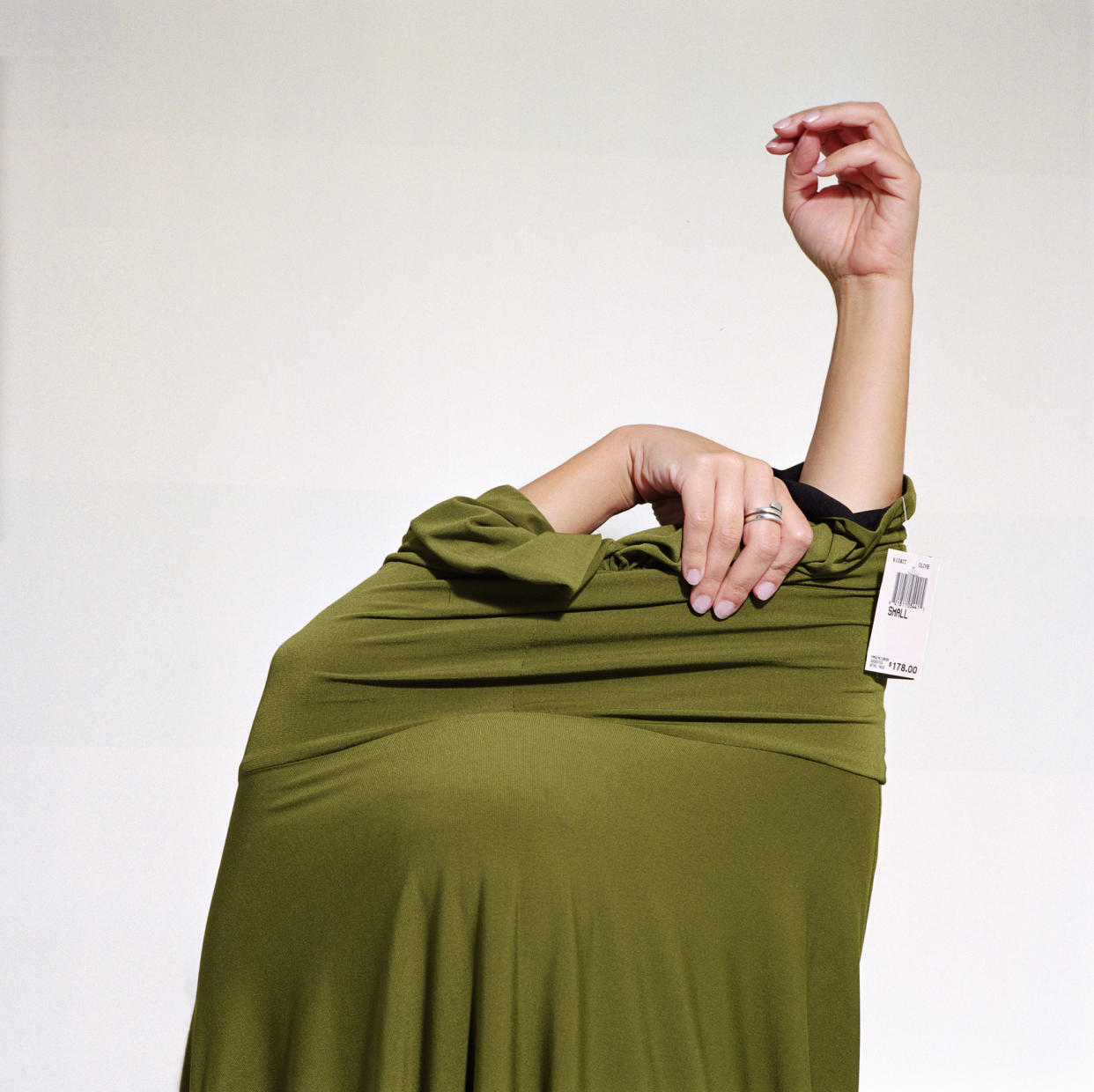Everything you need to know about Stitch Fix, the beloved billion-dollar fashion business

The online personal styling service Stitch Fix marked 2017 a mega-successful year.
The company, which chooses clothing for its subscribers and doles it out in scheduled deliveries, launched its own exclusive in-house brands, developed partnerships with household names in fashion, and launched an initial public offering on the Nasdaq stock exchange, though new reports indicate the company’s early success could be facing growing pains (an earnings call on March 12 might shed more light on the matter.)
While the last few years have brought trouble for traditional mall anchor stores and brick-and-mortar retailers struggling for relevance, direct-to-consumer is flourishing. It’s in that environment that Stitch Fix has grown — though its ultimate success is still TBD. So what is it that makes the tech company notable?
How it works
Katrina Lake launched Stitch Fix six years ago, meticulously mining data from shoppers about their purchasing behavior and style preferences from the beginning.
The service works like this: Sign up on the website with an email or Facebook account, and complete a profile and questionnaire that aim to identify your sartorial tastes. Once you’re finished, you choose how frequently you’d like shipments (or “Fixes,” as they’re called) and enter your payment information. Then you wait for a box of five items to be delivered to your door.
Stitch Fix is built upon a few assumptions: Its users either don’t like to shop, don’t know how to shop, or don’t have access to good shopping. They can’t be bothered to spend the time searching online, and might appreciate a little guidance.
“I have found the majority of people who want styling services don’t like to go shopping or don’t care to think about clothing,” says Charcy Evers, a retail analyst with her own personal styling service. “Getting dressed is a big hurdle; it hinders them in the morning. So services like this take that stressful element out of people’s lives.”
Stitch Fix shoppers are also enticed by a deal (who isn’t?): If you keep every item in your Fix, you save 25 percent on your order. It’s as much a perk for shoppers as it is for the company, which has a goal to reduce the amount of inventory the company is left with.
The more feedback you provide to Stitch Fix, the better suited your Fix will be for you.
A post shared by K A R I ⚕️✈️✌ (@fitnurse_kari) on May 23, 2016 at 4:10pm PDT
Terri Smith-Wright, a 56-year-old interior designer, first tried Stitch Fix in May after a friend referred her to the service. The Lafayette, Ind., resident says she used to enjoy shopping regularly, but as she grew older, she found that her local mall, only two miles from her home, disappointed her.
“It’s like there’s nothing for a woman my age at the mall anchor stores like Macy’s near me,” Smith-Wright tells Yahoo Lifestyle. “Our Macy’s is geared toward the farmer’s wife or college or high school kids. It’s the same thing everyone else has, or there are old-lady clothes. I’m not ready to go there yet!”
Smith-Wright completed the style survey: Business-casual transition pieces were a must, no shoes, and nothing that required dry cleaning. She received her first Fix about three weeks later, and she says she was initially impressed with the selections. She budgeted up to $250 per Fix, and planned to receive new shipments monthly.
“I found that they were able to provide things I couldn’t find in my community,” she says of her first Fix. “I’m mostly a business-casual jeans-wearer, but I also wanted stylish things.”
What about plus-size?
Even though the company is six years old, it only just introduced plus-size in 2017, meaning shoppers like Marcy Bates Harris had to wait years before they could subscribe.
The 52-year-old Air Force employee says shopping in Shreveport, La., isn’t great for straight-size people, let alone plus-size people.
“I get overwhelmed going into a store, and I usually leave a store a little depressed,” Bates Harris says. “In your house, at least you’re comfortable trying things on.”
Once Stitch Fix offered plus-sizes, beginning in Feb. 2017, Bates Harris signed on. Happy with most of her shipments, she didn’t want to forgo the company’s 25 percent discount on all items in her Fix if there were just one or two things she didn’t like.

So, like thousands of others, she takes advantage of secondary marketplaces like Facebook and resale websites like Poshmark to sell unwanted Stitch Fix items without sacrificing the savings. But if users keep their items — even if they’re unwanted — without providing feedback to the company, its assessment for what they actually like and what’s popular may be skewed.
Overall, Bates Harris says she was satisfied with the Stitch Fix experience, which helped the relatively reserved shopper expand her tastes. “It’s a fun day when I receive my Fix,” she says. (Indeed, there’s an entire community built around sharing unboxing Fix videos on sites like YouTube.) “I’d never tried on skinny jeans before, so when I first tried them on they were really tight, but I really like them a lot now.”
What if you actually like shopping?
In addition to the new plus-size offerings, Stitch Fix is beginning to add premium and “accessible luxury” retailers to its inventory, like Helmut Lang and Grey Jason Wu, which created five exclusive pieces for Stitch Fix clients based on the company’s consumer preferences data (items range in price from $225 to $395 and are available in sizes zero to 14).
“With its combination of human touch, algorithms, and personalization, Stitch Fix has allowed me to access its rich data, which helped me design the five new Stitch Fix-exclusive pieces from the Grey Jason Wu collection,” Wu says in a statement to Yahoo Lifestyle.

In theory, premium offerings might appeal to shoppers with higher budgets or trendier tastes. Though that wasn’t the case for this writer, a 24-year-old, Midwest-raised New York City transplant working in fashion. I have access to some of the world’s best shopping outside my door, and typically don’t have to worry whether designers offer clothing in my size (that is, I’m straight-size, falling under a size 8.)
While my own Fix was neatly arranged and personalized with a friendly letter from my stylist, I was nonplussed by the items I received: a $44 pair of tassel earrings I could have made myself, a $158 silk blue-and-black cheetah print blouse, a $188 pair of high rise skinny jeans, and a $50 polyester cardigan were not anything I’d have purchased on my own.
A post shared by A S H L E Y • M A E (@simplyashs_) on Nov 20, 2017 at 5:30pm PST
Perhaps the only item in my Fix I’d have considered keeping was a $168 off-the-shoulder ribbed dress, but I wasn’t sold on the idea that the quality and the price tag were in sync.
If Stitch Fix didn’t appeal to me, a fashion lover, then to whom could it appeal? Lake, Stitch Fix’s founder, says the company’s customer isn’t the coastal millennial going to Coachella that she’d first imagined. Instead, it’s more often a mom looking for hemlines long enough to wear to her child’s preschool, according to what she told the L.A. Times in June. (Stich Fix was not able to provide Yahoo Lifestyle with an interview, either with its founder or a company stylist, in time for this story.)
Does online shopping mean worse quality?
Zarah Matsuda Fritz, a 34-year-old high school culinary teacher, says she and three other coworkers each signed up to try Stitch Fix around the same time.
A few months later, all four of the high school employees ditched the service for much the same reason: quality. Matsuda Fritz had spent $2,000 over about six Fixes, but says that the quality of the clothing she received worsened considerably since she’d begun receiving shipments.
She was also frustrated when one of her students pointed out she had the same top as the culinary teacher — but spent $8 on it instead of the $60 that Matsuda Fritz spent.
“I’ll shop at Target and drop $300 easily, but when I do that, I’m walking away with a cart full of clothes. I’m not going to spend $300 on five items that don’t last,” she says.
A post shared by Michelle (@sweatstyleshelly) on Nov 19, 2017 at 7:49am PST
Stitch Fix isn’t just for women, of course. Its men’s offerings became available in Sept. 2016. Casey Tanksley, already a Stitch Fix customer herself, encouraged her husband, Leonard, to try the service too.
The 28-year-old, studying to become a pastor in Fort Wayne, Ind., is exactly the kind of shopper Stitch Fix is trying to court.
“I hate going to the store. I don’t hate shopping — I can shop on Amazon all day long,” Leonard says. “But I’m not a fan of going to try on clothes and trying to match things.”
As with many Stitch Fix user stories, the first shipments weren’t perfect, far from it. (“I’m not a slim guy by any stretch of the imagination, and each of my first few Fixes had slim-fit shirts. I was really upset.”)
But the soon-to-be pastor offered a shot at redemption. His next few Fixes were better, he says, and helped him think about clothes in new ways, thanks to the styling guide that Stitch Fix includes in every one of its shipments.
The best part of using Stitch Fix for Leonard Tanksley is putting on at-home “fashion shows” with his wife. The fashion procession is different than it is in a church, and the higher power is Stitch Fix data. But its power, like any religion, can be transformative.
Read more from Yahoo Style + Beauty:
Angelina Jolie, One of Hollywood’s Highest Paid Stars, Wore an Affordable Everlane Outfit
Tiffany Trump Quotes Muhammad Ali in Stylish Memorial Day Photo
Teen Faced Her ‘Biggest Fear’ and Wore a Swimsuit to the Beach
Follow us on Instagram, Facebook, and Twitter for nonstop inspiration delivered fresh to your feed, every day.
This story is a part of Yahoo Finance Presents: The Retail Revolution, March 5-9, 2018.


